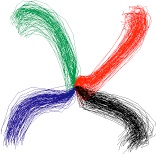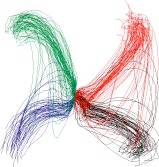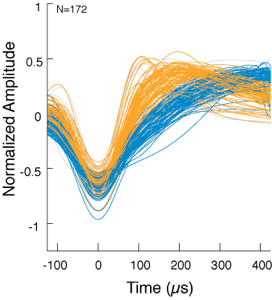Reach Target Selection

Trajectories of reaching movements from a central starting position to four different peripheral target positions. In the left panel, each reach target is presented alone, while in the right panel, reach targets must be selected from distractors, resulting in greater curvature of the movement trajectories.
Reach movement trajectories in a target selection task




Extracellularly-recorded action potentials from certain types of cortical inhibitory neurons tend to have narrower waveforms than excitatory pyramidal cells (left panel). This information can be used to classify cortical neurons as putative inhibitory (orange) or putative pyramidal (blue) cells.
In a target selection task for reaching movements, we found that task-related putative inhibitory neurons were virtually all involved in target selection rather than in triggering the onset of reaching movements (upper right panel). This makes sense if we postulate that target selection involves suppression of non-selected goals. In contrast, putative pyramidal cells were involved both in target selection and in triggering the onset of the reaching movement (lower right panel).
Roles of narrow- and broad-spiking PMd neurons in reach target selection
Target selection has been studied extensively for the saccadic eye movement system, but much less is known about how visual targets are selected for other actions, such as reaching movements.
This project investigates the roles of the superior colliculus (SC) and dorsal premotor area (PMd) in target selection for visually-guided reaching.
The SC is traditionally considered an eye-movement area, but recent evidence suggests that it may be part of a more general-purpose target selection system. Indeed, our preliminary experiments provide evidence that the SC plays a role in target selection for reaches to visual targets.